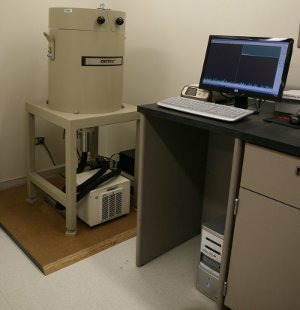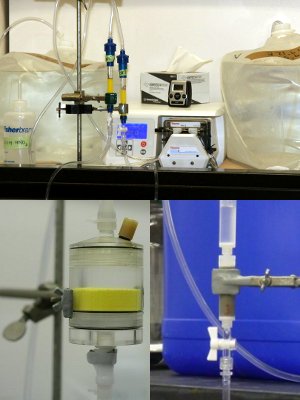Analysis of cesium radioisotopes in seawater

|
| Fig.1 High purity germanium detector for gamma spectrometry in a lead shielding. |
The accident at Fukushima Daiichi nuclear power plant following tsunami wave on March 11, 2011 released large quantities of cesium radioisotopes 137Cs (half-life 30.08 years) and 134Cs (half-life 2.07 years) to both the atmosphere and the ocean. Direct gamma spectrometric analysis was used for seawater samples with higher levels of these radionuclides from the near proximity of the power plant. Direct measurement is not sensitive enough for analysis of seawater with lower levels of radioactivity and chemical treatment of larger seawater volume is required.
The major radioactive constituent of seawater is naturally occurring potassium isotope 40K (about 0.01% of total potassium). Its activity in seawater is about 11,000 Bq/m3 (seawater of salinity 35). The main source of the artificial radioactivity in the Pacific Ocean was global atmospheric fallout from nuclear weapons testing in 20th century. After decades of radioactive decay and lateral and vertical removal processes, 137Cs activity in the surface layer was 1-2.5 Bq/m3 and 134Cs was not present in the entire North Pacific ocean prior to the accident in 2011.

|
| Fig.2 Concentration of cesium from seawater by AMP-PAN (yellow) and KNiFC-PAN (grey) ion-exchangers manufactured at the Czech Technical University (F. Sebesta). Selection of column size is based on the sample volume. |
At the University of Hawaiʻi, selective composite ion-exchangers are used for cesium concentration from seawater. First, samples are filtered to remove undissolved particles. Clear water is then passed through a layer of the ion-exchanger in a chromatographic column (Fig.2). Usually, the process reduces the volume by the factor of 5,000. Loaded ion-exchanger is then measured in a suitable container by gamma spectrometry using sensitive high purity germanium (HPGe) detectors, one such detector is shown on Fig.1.
The method used in our laboratory has detection limit for 137Cs analysis 0.2 and 0.7 Bq/m3 for 100 L and 25 L sample, respectively, and 3 days of counting by conventional HPGe detector. Such sensitivity is high enough for analysis of pre-Fukushima levels in surface and near-surface seawater, any increase of radioactivity due to the accident is easily detected.
The sensitivity of the method could be improved for samples from deep ocean with even lower levels of 137Cs. It requires dissolving of the ion-exchanger, chemical cleaning of cesium from potassium, and using ultra low-background gamma spectrometric system in an underground laboratory (to reduce background cosmic-rays radiation).
Additional information:
- Results from the University of Hawaiʻi (March 2013), Click here to read more.
- Video of the first tsunami wave in Kasennuma town, Japan (160 km North from Fukushima Daiichi power plant) on www.youtube.com.
- Details about the nuclear accident at www.world-nuclear.org.
Contact: kamenik at hawaii.edu
Last update: January 31, 2013

